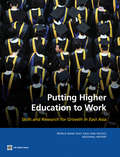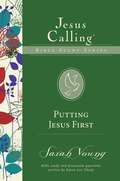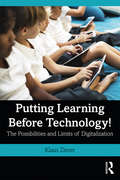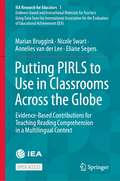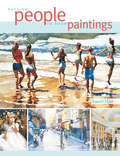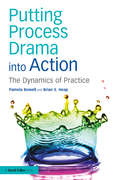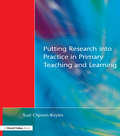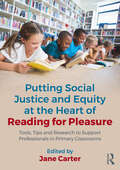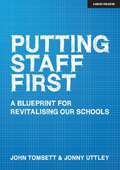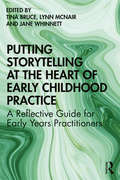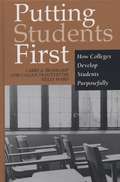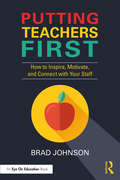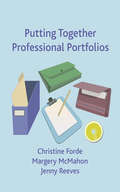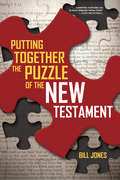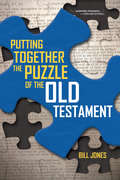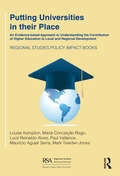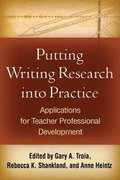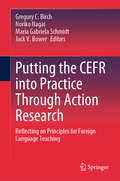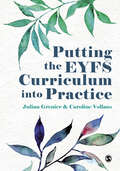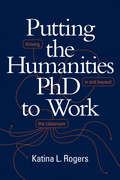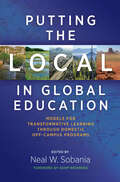- Table View
- List View
Putting Higher Education to Work
by Shahid Yusuf Prateek Tandon Emanuela Di GropelloImpressive gains have been made in expanding access to higher education in East Asia over the past few decades, and the significance of higher education is expected to increase as developing economies face the challenge of sustaining growth in a competitive environment. Still, much work needs to be done if higher education is to realize its full potential to produce the skills and research needed for innovation and growth. “Disconnects” between higher education institutions and the skills and research users and providers they interact with—firms, research institutes, earlier education institutions, and other skill providers—have undermined the functioning of the subsector. In order for higher education institutions to be more responsive to the labor market, they should be better aligned with what employers and employees need and better connected among themselves and other skills providers. They also require stronger linkages with firms and other research providers to deliver research that can enhance innovation and productivity. Enacting policy reforms in the areas of financing, public sector management, and stewardship of the entire system will help the region achieve better skills and research outcomes and, ultimately, growth. Putting Higher Education to Work: Skills and Research for Growth in East Asia takes an in-depth and comprehensive look at higher education in East Asia—how it has changed, how it will continue to evolve, and how it can be improved. Using innovative firm surveys and the latest available evidence from the region, the authors identify functional skills needed for competitiveness and productivity, and look at how higher education systems can produce the type of skills and kind of commercially applicable research that will drive growth. Though focused on the developing countries in East Asia, the book’s methodologies, messages, and careful guidance will be of interest and value to researchers and policy makers in all regions where higher education and training are important issues. This book is the first title in the East Asia and Pacific Regional Report Series, a series that presents analyses of issues relevant to the region, drawing on the global knowledge and experience of the World Bank and its partners. This series aims to inform public discussion, policy formulation, and development practitioners’ actions, and thereby turn challenges into opportunities.
Putting Jesus First (Jesus Calling Bible Studies)
by Sarah YoungIn Putting Jesus First, the eighth study in the Jesus Calling Bible Study Series, you will explore what it means to place Christ first in every part of your life–and rely on Him in the busy times, anxious times, uncertain times, and lonely times. While the world offers many distractions and priorities for you to chase, the Bible is clear that peace and fulfillment only come as you put God's agenda first at all times. As Jesus promised, "Seek first [God's] kingdom . . . and all these things will be given to you as well" (Matthew 6:33). Each of the Jesus Calling Bible studies includes devotional readings from Jesus Calling, selected passages of Scripture for reflection, Bible study questions, and additional questions to help you apply the material. This study can be used for personal reflection and Bible study or in a small-group setting.
Putting Learning Before Technology!: The Possibilities and Limits of Digitalization
by Klaus ZiererFor many, digitalization is the key to revolutionizing education. But what do we know about its impact on the learning process? What benefits are on offer and what are the risks? What are the consequences for educational interventions? Putting Learning Before Technology! discusses these questions and more in a thorough exploration of the use of technology in educational settings. Central to the author's argument is that digitalization as a sole and structural measure will bring little benefit and that the teachers who bring lessons to life are much more important. Features of the book include: evidence from Visible Learning research to scientifically frame the effectiveness and pitfalls of technology in the classroom; real-life classroom examples; graphics to clearly illustrate key concepts and studies. This book is a fascinating analysis of the impact, possibilities, and limits of the use of technology within education, and will appeal to teachers and teacher-trainers in any setting or country.
Putting PIRLS to Use in Classrooms Across the Globe: Evidence-Based Contributions for Teaching Reading Comprehension in a Multilingual Context (IEA Research for Educators #1)
by Marian Bruggink Nicole Swart Annelies van der Lee Eliane SegersThis open access book provides teachers with approaches to strengthen reading comprehension instruction based on scientific research and evidence-based didactic principles. In this volume, the Progress in International Reading Study (PIRLS) framework is used to inform teachers about the skills and knowledge that students need to comprehend certain texts. The book gives practical guidance on how a teacher can help students to learn these skills, specifically, when teaching reading to multilingual students. Good practices from schools in five participating PIRLS countries—Chile, Chinese Taipei, England, Georgia, and Spain—are shared. A description of the schools’ education in reading comprehension is provided with practical tips and example lessons. These insights into daily reading education in multilingual classrooms across the globe can be an inspiration to teachers all over the world.
Putting People in Your Paintings
by Laurel HartCapture the essence of people in your paintingsAdd a personal touch to you watercolors with 11 step-by-step demonstrations that cover people in a variety of scenes and situations. Award-winning artist, Laurel Hart, gives you the techniques you need to capture the living, breathing essence of people. Inside you'll find:Tips for seeing the basic shapes of your subject using lighting and shading techniquesEasy methods for successful design and compositionTechniques for translating photographs into compelling, beautiful paintingsComplete instruction for placing people in settings including cityscapes, landscapes and interiorsLaurel guides you through the process with practical tips, chapter summaries and motivational "Hart-felt insights" that will inspire you to see the beauty of your subject and transfer your emotional response to watercolor. Putting People in Your Paintings gives you all the tools you need to make your paintings come alive!
Putting Process Drama into Action: The Dynamics of Practice
by Pamela Bowell Brian S. HeapThis new book provides a clear and accessible guide on best practice to support teachers when using process drama in establishing creative learning partnerships with their students. It offers a detailed analysis and explores the roles of actor, director and playwright that the teacher must adopt in order to develop the ‘thinking on your feet’ skills and knowledge necessary to deliver a complete process drama experience. Addressing the dynamic nature of process drama, it provides a clear and rigorous explanation of the theory of process drama and links it to practice. Drawing on a wide range of detailed examples from the authors’ international and cross-cultural practice, it demonstrates how an effective process drama operates in action. Written to help practitioners and students produce powerful, artistic and educative experiences, chapters cover: pedagogy and the improvised nature of the art form; the structural framework and making shifts in the drama; the role of actor, director, playwright and teacher; monitoring emotional range; progression and the importance of reflection; the spiral of creative exchange and the complexities of co-creativity. Putting Process Drama into Action will be an essential guide for students undertaking initial teacher training at primary level, in addition to those studying both Drama and English at secondary level. It will also prove to be essential reading for specialist and non-specialist teachers in the primary and secondary sectors who teach, or wish to teach, process drama.
Putting Research into Practice in Primary Teaching and Learning
by Graham Upton Suzi Clipson-BoylesFirst Published in 2000. Routledge is an imprint of Taylor & Francis, an informa company.
Putting Social Justice and Equity at the Heart of Reading for Pleasure: Tools, Tips and Research to Support Professionals in Primary Classrooms
by Jane CarterThis essential book discusses what reading for pleasure is and what it is not, introducing some fundamental ideas about how we learn to read and how this process can impact a child’s identity as a reader in classrooms that promote equality, inclusion and diversity.The profile and importance of Reading for Pleasure has grown significantly over the last few years and is now firmly embedded in both government policy and the Ofsted framework. Developing a Reading for Pleasure school that is truly inclusive of the whole school community, however, can require a culture shift in relation to the teaching of reading, representation in the reading environment and the knowledge, and attitudes of the school community. This book seeks to use the current research, teacher case studies and the voices of children to address some of the issues that teachers and pre-service teachers encounter when trying to develop an inclusive Reading for Pleasure culture within their schools. Each chapter is co-authored by teachers and researchers and includes case studies and children’s perspectives.It provides practical and evidence-based advice, lesson ideas and creative ideas to both support and challenge all school leaders, staff and student teachers in their journey to create readers rather than children that can just read.
Putting Staff First: A blueprint for a revitalised profession
by John Tomsett Jonny UttleyIf we do not ensure, first and foremost, that our teachers are feeling physically and mentally well, they cannot be their best for their students. Consequently, a school which does not prioritise staff wellbeing is disadvantaging its own students. 'Students first' is a misplaced sentiment: the best thing for students is a happy, healthy, motivated, well-trained, expert staff. By putting staff first you are providing for students the one thing which will help them make good progress in their learning: truly great teaching. Whilst it is easy to say that schools would not exist if it were not for the students, the glib converse is that without truly great school staff, the students would not be taught. What we need - as recruiting subject specialist teachers, school leaders and specialist support staff becomes increasingly difficult - is a revolution in how we treat our school staff. We have to put our staff before our students because it is the only hope we have of securing what our students need most: a world class education. The longer our schools are populated with hypoxic adults, we imperial all our futures. What follows is a blueprint for the school system which puts our school staff before students.
Putting Staff First: A blueprint for a revitalised profession
by John Tomsett Jonny UttleyIf we do not ensure, first and foremost, that our teachers are feeling physically and mentally well, they cannot be their best for their students. Consequently, a school which does not prioritise staff wellbeing is disadvantaging its own students. 'Students first' is a misplaced sentiment: the best thing for students is a happy, healthy, motivated, well-trained, expert staff. By putting staff first you are providing for students the one thing which will help them make good progress in their learning: truly great teaching. Whilst it is easy to say that schools would not exist if it were not for the students, the glib converse is that without truly great school staff, the students would not be taught. What we need - as recruiting subject specialist teachers, school leaders and specialist support staff becomes increasingly difficult - is a revolution in how we treat our school staff. We have to put our staff before our students because it is the only hope we have of securing what our students need most: a world class education. The longer our schools are populated with hypoxic adults, we imperial all our futures. What follows is a blueprint for the school system which puts our school staff before students.
Putting Storytelling at the Heart of Early Childhood Practice: A Reflective Guide for Early Years Practitioners
by Tina Bruce Lynn McNair Jane WhinnettPutting Storytelling at the Heart of Early Childhood Practice is a brilliantly engaging and practical book that highlights the essential nature of storytelling in all walks of life, and how to best cultivate this in the early years classroom. The authors use a compelling Froebelian approach to explore the role of storytelling not just in the development of literacy but also in the development of communication and language and for maintaining good mental health and wellbeing. Drawing on primary and contemporary research, and presented by a range of experienced authors, this book covers important topics such as: The benefits of regularly practising storytelling Storytelling during play activities Group dynamics in constructing narratives The roles of props and fantasy concepts in storytelling This accessible guide is ideal for all early years practitioners looking to encourage literacy, communication and well-being in a supportive and creative environment, and for policymakers looking to develop best practice in the early years classroom.
Putting Students First: How Colleges Develop Students Purposefully (JB - Anker)
by Kelly Ward Larry A. Braskamp Lois Calian TrautvetterIn Putting Students First, the authors argue that colleges can and should invest in holistic student development by recognizing and building on the students’ search for purpose in life, intellectually, spiritually, and morally. Based on a study conducted at ten religiously-affiliated schools, the book urges all colleges to rethink their approach to teaching and advising the increasingly diverse students of today; their critical mission should be to prepare students to become ethically responsible and active contributors to society, as well as critical thinkers and skilled professionals. Putting Students First offers perspectives and recommendations in areas of holistic student development such as Understanding millennial college students The role of faculty in defining culture The design and implementation of curriculum The impact of cocurricular involvement Fostering relationships with on-campus and off-campus communities By organizing the campus environment into “4Cs”—culture, curriculum, cocurriculum, and community—the authors create a conceptual framework for faculty, student affairs staff, and administrators to discuss, plan, and create college environments that effectively support the learning and development of students. Each chapter includes an introduction, evidence and analysis, a summary, and questions to help readers consider how to develop students holistically on their own campuses.
Putting Teachers First: How to Inspire, Motivate, and Connect with Your Staff
by Brad JohnsonIn Putting Teachers First, author and speaker Brad Johnson offers tons of invaluable tips for building and maintaining strong, dynamic relationships with your teachers, leading to greater job satisfaction, lower turnover, and improved performance across the board. You’ll learn how to boost teacher morale and drive engagement by providing sincere feedback and recognition, creating incentives for teaching excellence, building trust between all faculty members, and more. Topics covered: The Importance of Teacher Satisfaction Motivating Your Teachers to Succeed Creating a Culture of Appreciation Learning to Become a Selfless Leader Inspiring Teachers to Remember Their Purpose Developing Your Emotional Intelligence Communicating and Connecting Effectively Building a Cohesive Team Celebrating Successes Each chapter includes practical advice as well as inspiring stories and anecdotes to motivate you on your journey.
Putting Together Professional Portfolios
by Dr Margery Mcmahon Dr Christine Forde Dr Jenny ReevesWith the increasing emphasis on continuing professional development for teachers and all educational practitioners, the use of portfolios to plan, chart and review professional development is now widespread. Drawing directly from their experience of developing portfolios and portfolio-based assessment, and from current research, this book enables the reader to: - design and plan a portfolio - chart and analyse relevant professional experiences - reflect critically on practice - assess performance against standards and competences frameworks - present evidence of practice and achievements - plan their continuing professional development There are Chapter Objectives, Key Questions and Tasks in every chapter, which adds to the practical focus of the book. An essential read for teachers, teaching assistants, any practitioner assembling a Continuing Professional Department (CPD) portfolio, those working towards further qualifications such as Chartered Teacher status, newly qualified and probationary teachers and anyone involved in supporting and mentoring CPD.
Putting Together the Puzzle of the New Testament
by Bill JonesWith hundreds of pages of stories, theology and strange visions, who wouldn't feel overwhelmed and confused about the New Testament? How does it all fit together? But imagine that the New Testament was a 1,000 piece puzzle. It's easier to figure out what you're putting together if you have the picture on the box to go by and the corners and straight edges as guides. The chapters in this book provide the puzzle's box cover, corners and straight-edged pieces, demystifying the whole picture of what you are assembling. Armed with these advantages, when you read or study New Testament passages, you will easily understand how the puzzle fits together.
Putting Together the Puzzle of the Old Testament
by Bill JonesWith eight to nine hundred pages of names like Melchizedek, Mephibosheth, Meshelemiah, Michmethath, Mikhtam, who wouldn't feel confused? If the Old Testament were one of those 1,000 piece puzzles, then this book provides the puzzle's box cover so you can understand the complete picture of what you are assembling. It also helps you put together the important four corners and all the straight edged pieces so you have a completed border or reference of the puzzle. Armed with these two advantages, when you read or study Old Testament stories, you will understand how all the pieces fit together. This book is ideal for those who have little or no familiarity with the Old Testament or for pastors and lay leaders to help teach a better understanding of the Old Testament.
Putting Universities in their Place: An Evidence-based Approach to Understanding the Contribution of Higher Education to Local and Regional Development (Regional Studies Policy Impact Books)
by Mark Tewdwr-Jones Paul Vallance Louise Kempton Maria Conceição Rego Lucir Reinaldo Alves Maurício Aguiar SerraThere have been several attempts in recent years to create conceptual frameworks and models to help universities and policy makers understand the role and contribution of higher education to local and regional development. However, these models have failed to fully reflect or give insufficient attention to the impact of the regional context (economic, social, political), the policy environment for higher education and territorial development and the diversity of management and leadership structures of universities themselves. This has led to the development of static models that rarely work outside of the immediate context in which they were developed and therefore risk leading to design of policies that are not fit for purpose. This Policy Expo is the result of work with partners in Europe, South America, Africa, Asia and Australia to develop a new approach, the ORPHIC Framework, to think about how the university can be adapted to the specificity of institutional and local contexts. The book examines: • What are the different roles that universities play in local and regional development and how do these manifest themselves? • How can we learn from comparing practice and experience internationally, and to what extent are policies aimed at promoting university–region relationships transferrable? • What are the internal university factors, such as management and leadership, history, mission, structures, and the external factors, such as territorial development policy context, governance system, nature of the ‘place’, that might help us explain the nature of the relationship?
Putting Writing Research into Practice
by Rebecca Shankland Gary TroiaWhat are the most effective methods for teaching writing across grade levels and student populations? What kind of training do teachers need to put research-validated methods into practice? This unique volume combines the latest writing research with clear-cut recommendations for designing high-quality professional development efforts. Prominent authorities describe ways to help teachers succeed by using peer coaching, cross-disciplinary collaboration, lesson study, and other professional development models. All aspects of instruction and assessment are addressed, including high-stakes writing assessments, applications of technology, motivational issues, writing in different genres and subject areas, and teaching struggling writers.
Putting the CEFR into Practice Through Action Research: Reflecting on Principles for Foreign Language Teaching
by Noriko Nagai Gregory C. Birch Jack V. Bower Maria Gabriela SchmidtThis book provides an overview of an action research model which utilizes the Common European Framework of Reference for Languages (CEFR) and stresses the importance of systematically researching classroom practice. It introduces the complementary nature of the CEFR and action research, the CEFR, and the CEFR-focused Action Research Model (CARM). The book includes seven case studies guided by the model and concludes with an overall assessment of the efficacy of the CARM as a way to facilitate action research into CEFR-informed practice. Undertaken in a Japanese educational context, the focus of the book is squarely on classroom-based CEFR-focused action research concerning issues that all educators face, such as course design, materials development/selection, classroom implementation, learner autonomy and assessment.
Putting the EYFS Curriculum into Practice
by Julian Grenier Caroline VollansHow should practitioners and leaders set about designing and implementing their curriculum in the Early Years Foundation Stage? Written by experts in the field, this book provides clear, practical guidance on each of the 7 areas of learning and development in the revised (2021) EYFS. Chapters cover key topics including, assessment, inclusion of children with SEND, English as an Additional Language, equalities, anti-racism, provision for disadvantaged children, professional development and using research and evidence. Designed for practising teachers, early years educators, students on early years degrees and trainee teachers, this engaging book provides an accessible guide to putting revised EYFS into practice. Dr Julian Grenier CBE is the headteacher of Sheringham Nursery School and Children’s Centre. He was the lead writer of Development Matters (2021). Caroline Vollans is a psychoanalyst and author. She writes for a wide range of early years publications and is author of Wise Words: How Susan Isaacs Changed Parenting.
Putting the EYFS Curriculum into Practice
by Julian Grenier Caroline VollansHow should practitioners and leaders set about designing and implementing their curriculum in the Early Years Foundation Stage? Written by experts in the field, this book provides clear, practical guidance on each of the 7 areas of learning and development in the revised (2021) EYFS. Chapters cover key topics including, assessment, inclusion of children with SEND, English as an Additional Language, equalities, anti-racism, provision for disadvantaged children, professional development and using research and evidence. Designed for practising teachers, early years educators, students on early years degrees and trainee teachers, this engaging book provides an accessible guide to putting revised EYFS into practice. Dr Julian Grenier CBE is the headteacher of Sheringham Nursery School and Children’s Centre. He was the lead writer of Development Matters (2021). Caroline Vollans is a psychoanalyst and author. She writes for a wide range of early years publications and is author of Wise Words: How Susan Isaacs Changed Parenting.
Putting the Humanities PhD to Work: Thriving in and beyond the Classroom
by Katina L. RogersIn Putting the Humanities PhD to Work Katina L. Rogers grounds practical career advice in a nuanced consideration of the current landscape of the academic workforce. Drawing on surveys, interviews, and personal experience, Rogers explores the evolving rhetoric and practices regarding career preparation and how those changes intersect with admissions practices, scholarly reward structures, and academic labor practices—especially the increasing reliance on contingent labor. Rogers invites readers to consider how graduate training can lead to meaningful and significant careers beyond the academy. She provides graduate students with context and analysis to inform the ways they discern their own potential career paths while taking an activist perspective that moves toward individual success and systemic change. For those in positions to make decisions in humanities departments or programs, Rogers outlines the circumstances and pressures that students face and gives examples of programmatic reform that address career matters in structural ways. Throughout, Rogers highlights the important possibility that different kinds of careers offer engaging, fulfilling, and even unexpected pathways for students who seek them out.
Putting the Local in Global Education: Models for Transformative Learning Through Domestic Off-Campus Programs
by Neal W. SobaniaThe position taken in this volume is that domestic off-campus study can be just as powerful a transformative learning experience as study overseas, and that domestic programs can equally expand students’ horizons, their knowledge of global issues and processes, their familiarity and experience with cultural diversity, their intercultural skills, and sense of citizenship.This book presents both the rationale for and examples of “study away”, an inclusive concept that embraces study abroad while advocating for a wide variety of domestic study programs, including community-based education programs that employ academic service-learning and internships.With the growing diversification—regionally, demographically, culturally, and socio-economically—of developed economies such as the US, the local is potentially a “doorstep to the planet” and presents opportunities for global learning. Moreover, study away programs can address many of the problematic issues associated with study abroad, such as access, finance, participation, health and safety, and faculty support. Between lower costs, the potential to increase the participation of student cohorts typically under-represented in study abroad, the lowering of language barriers, and the engagement of faculty whose disciplines focus on domestic issues, study at home can greatly expand the reach of global learning.The book is organized in five sections, the first providing a framework and the rationale for domestic study way programs; addressing administrative support for domestic vs. study abroad programs; exploring program goals, organization, structure, assessment and continuous improvement; and considering the distinct pedagogies of experiential and transformative education.The second section focuses on Semester Long Faculty Led Programs, featuring examples of programs located in a wide variety of locations – from investigations into history, immigration, culture, and the environment through localities in the West and the Lowcountry to exploring globalization in L.A and New York. Section three highlights five Short Term Faculty Led Programs. While each includes an intensive immersive study away experience, two illustrate how a 7 – 10 day study away experience can be effectively embedded into a regular course taught on campus. The fourth section, on Consortium Programs, describes programs that are either sponsored by a college that makes its program available to consortium members and non-members, or is offered by an independent non-for-profit to which institutions send their students. The final section on Community Engagement and Domestic Study Away addresses the place of community-based education in global learning and provides examples of academic programs that employ service-learning as a tool for collaborative learning, focusing on issues of pedagogy, faculty development and the building long-term reciprocal relationship with community partners to co-create knowledge.The book is intended for study abroad professionals, multicultural educators, student affairs professionals, alternative spring break directors, and higher education administrators concerned about affordably expanding global education opportunities.
Puvi Iyal (Geography) 11th Standard - Tamilnadu Board
by Training State Council of Educational ResearchPuvi Iyal (Geography) Textbook for the 11th Standard Students, preparing for Tamil Nadu State Board Exam.
Puvi Iyal (Geography) 12th Standard - Tamilnadu Board
by Training State Council of Educational ResearchPuvi Iyal (Geography) Textbook for the 12th Standard Students, preparing for Tamil Nadu State Board Exam.
